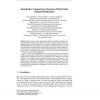Free Online Productivity Tools
i2Speak
i2Symbol
i2OCR
iTex2Img
iWeb2Print
iWeb2Shot
i2Type
iPdf2Split
iPdf2Merge
i2Bopomofo
i2Arabic
i2Style
i2Image
i2PDF
iLatex2Rtf
Sci2ools
GCB
2010
Springer
2010
Springer
Quantitative Comparison of Genomic-Wide Protein Domain Distributions
Abstract: Investigations into the origins and evolution of regulatory mechanisms require quantitative estimates of the abundance and co-occurrence of functional protein domains among distantly related genomes. Currently available databases, such as the SUPERFAMILY, are not designed for quantitative comparisons since they are built upon transcript and protein annotations provided by the various different genome annotation projects. Large biases are introduced by the differences in genome annotation protocols, which strongly depend on the availability of transcript information and well-annotated closely related organisms. Here we show that the combination of de novo gene predictors and subsequent HMM-based annotation of SCOP domains in the predicted peptides leads to consistent estimates with acceptable accuracy that in particular can be utilized for systematic studies of the evolution of protein domain occurrences and co-occurrences. As an application, we considered four major classes o...
Annotation | Biometrics | GCB 2010 | Genome Annotation | Protein |
| Added | 11 Feb 2011 |
| Updated | 11 Feb 2011 |
| Type | Journal |
| Year | 2010 |
| Where | GCB |
| Authors | Arli A. Parikesit, Peter F. Stadler, Sonja J. Prohaska |
Comments (0)

